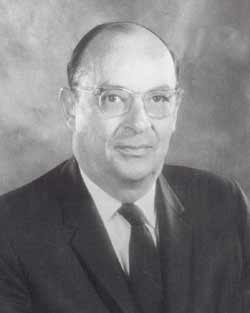John Bardeen
John Bardeen: Biography
Born: 23 May 1908
Died: 30 January 1991
John Bardeen was born in 1908 to Charles Russell and Althea Harmer Bardeen. His father was dean of the
University of Wisconsin medical school. Bardeen was an extraordinary student who went from third grade straight to junior high school. At age fifteen he started college at the University of Washington, where he majored in engineering and also earned a master’s degree in electrical engineering. He finished his master’s degree during the Great Depression, when jobs were hard to come by, but he found a position for Gulf Oil as a geophysicist. After three years he returned to school and earned a doctorate in mathematical physics at Princeton University in 1935.
Bardeen taught at Harvard University for a few years and married Jane Maxwell in 1938 while living in Cambridge. They had three children. During World War II he worked at the Naval Ordnance Labs to help design defense systems against magnetic mines and torpedoes. After the war he accepted a generous offer from William Shockley to work at Bell Labs. He worked especially well with Walter Brattain, another member of Shockley’s research group. In 1947 Bardeen and Brattain developed the point-contact transistor, which was based on the insight that electrons behave differently at the surface of metals. Shockley quickly made improvements on the transistor design and developed the junction transistor. The three shared the 1956 Nobel Prize in Physics.
In 1951 Bardeen quit Bell Labs to take an academic position at the University of Illinois. At the University of Illinois Bardeen studied superconductivity and developed a theory about how extremely cold metals function as such good conductors. In 1972 he was awarded a second Nobel Prize for this work. Bardeen consulted for Xerox, General Electric, and other companies interested in applying theoretical physics to technology. He remained active at the University of Illinois for the rest of his career and was still involved in the scientific community when he died in 1991.
